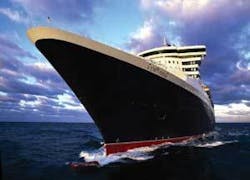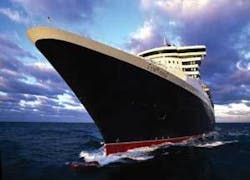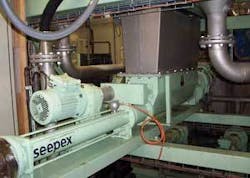Queen Mary 2 treats sludge at sea
Seepex solves sewage treatment problems on land and at sea.
Ocean liners no longer need to collect waste and sludge produced on board for treatment once transported to onshore facilities. An innovative sludge treatment system developed by the UK company seepex now treats the waste at sea.
Having helped major water companies create efficient sewage waste treatment solutions, seepex engineers were invited onboard the Queen Mary 2 ocean liner to provide a sludge management solution. Up until now any waste and sludge that ocean liners generate have been collected in containers for treatment and disposal on land; however an elaborate plant developed by seepex treats waste for the 1,253 officers and crew and up to 2,620 passengers on board the Queen Mary 2.
With limited space below decks, the company developed an innovative sludge waste treatment solution installed on board the ocean liner. Pump modules were pre-assembled to ease installation, and the pumps were supplied on a self-contained pump skid to save space. Several different types of seepex pumps are involved in the waste treatment process including pumps from the BTI range, which transport dewatered sludge. The sludge, with a solid content of approximately 20 percent, is transferred from the centrifuge to the drier. After a drying phase, the dewatered sludge is then incinerated with the combustion heat generated being fed back into the ship’s environmentally friendly energy system.
Seepex sludge treatment equipment
Seepex produces an enormous range of progressive cavity pumps capable of flows between 0.1/hr to 500m3/h with pressures up to 48 bar in standard design.
Seepex progressive cavity pumps, macerators, and control systems are incorporated into a state-of-the-art quality management system. The modular system is made up of eight product groups and 27 ranges. Manifold constructional designs facilitate purposeful adaptation to diverse operating conditions of almost all branches of industry.
In particular, the wastewater treatment industry has developed into one of the most important areas with complex mechanical, biological and chemical processes. In this respect seepex progressive cavity pumps and macerators are used in almost all processes.
Pumps from seepex in product group N form the basic product group of all seepex progressive cavity pumps. All other seepex pumps are based on this standard pump. They can be supplied with various rotor/stator geometries (conventional, 6L and Tricam geometry) and can be used in almost all branches of industry for pumping low viscous to highly viscous media with or without solids.
These pumps afford steady and low-pulsation pumping with a high self-priming rate, even with air or gas-liquid mixtures of up to 8.5 mWS. Installation in all positions and a large spherical entrance port are possible. Rotation direction and thus delivery flow is reversible.
The BT pump range from seepex features a rectangular feed hopper with compression zone and auger feed screw. The length of the hopper opening is variable to suit application conditions. Pumps from this range are used for transporting highly viscous media with a low degree of intrinsic flowability. The filling of the conveying elements through a cylindrical/conical compression zone is optimum. The compact design is with directly flange-mounted drive (block design), but also available with free shaft end. The conveying capacities are from 100 l/h to 300 m3/h and pressures are possible up to 36 bar.
The BTI pump range features a rectangular feed hopper with integrated bridge breaker. The Bridge breaker has two counter running rotating paddle shafts and a separate drive. The compression housing is dismountable for service work. The length of the hopper opening is variable to suit the application conditions. A cylindrical/conical compression zone allows an optimum filling of the conveying elements. The pump is manufactured in a compact design with directly flange-mounted drive (block design) but also available with a free shaft end (TINS range). Pumps of this range are used for pumping highly viscous to airtight products that tend to form bridges above the auger feed screw. The conveying capacities are from 100 l/h to 130 m3/h and pressures are possible up to 36 bar.
Author’s Note
Tanja Kaup of seepex is based in Bottrop, Germany.


